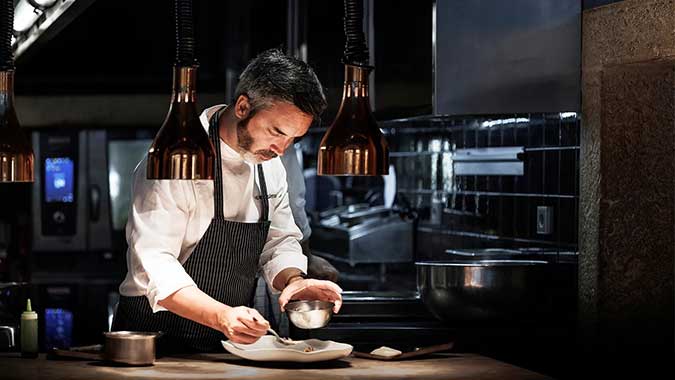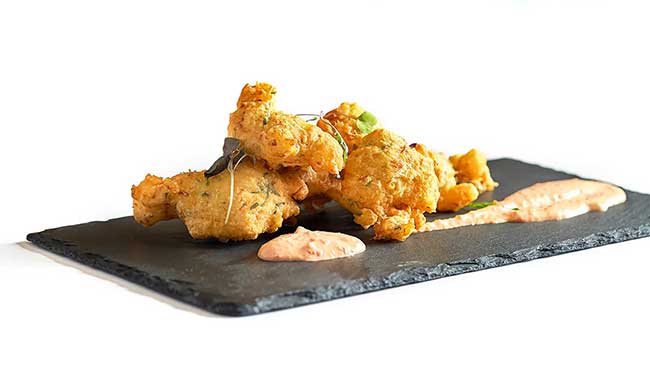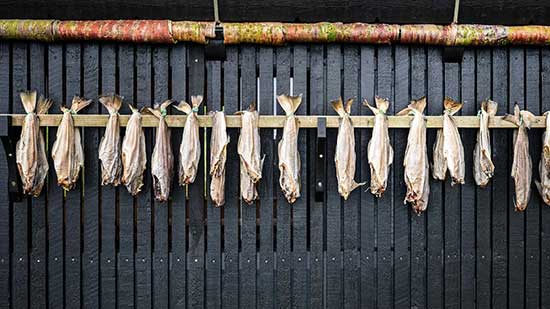Life style
A fish that sparked a national obsession

Bacalhau (salt cod) is a deep part of Portugal’s culinary identity. But the fish is found far from the country’s shores, so how did this love affair come to be and continue today?
On a cold winter’s evening in Portugal, it might come to your table com natas – fresh from the oven and bubbling in cream – layered between fried potato and sliced onion and spiced with nutmeg. Weaving through Lisbon’s steep and cobbled streets, it wouldn’t take long before you found someone serving it as a light and crispy fritter, dusted with a little coarse salt and dished up with a pot of pungent aioli. You could buy it shaped as mouth-sized fried potato dumplings pastéis style, flavoured with parsley and garlic, for a walk along the banks of Porto’s Douro River. You might even come across it as part of a hearty southern bread soup, topped with coriander and a poached egg.
That’s because bacalhau – or salt cod – which sits at the heart of all these dishes, runs deep through Portugal’s culinary identity, with the country consuming 20% of the world’s supply. In fact, so central to Portuguese hearts (and stomachs) is this ingredient, that the saying goes “there are 365 ways to prepare salted cod, one for each day of the year”.
But for a fish that is found only in the icy depths of the North Atlantic Ocean – far from Portugal’s shores – the country’s love affair with salt cod is a puzzling one. How exactly did it end up on Portuguese plates? The answer is wrapped up in more than 500 years of intriguing history.
Take a trip today to most restaurants, markets and cafés across the country and you’ll find salt cod in one form or another. It even plays a starring role at hip Lisbon restaurant Alma, which earned its first Michelin star within nine months of opening and added a second star soon after.

“It’s funny, sometimes Michelin star chefs or high-end cuisine chefs don’t value salted cod because they don’t see it [fitting] within this type of gastronomy,” said Alma executive chef and owner Henrique Sá Pessoa, of the typically humble comfort food. “But I always have and always will have cod on my menus.”
He assures visitors that a salt cod creation will also feature on the menu of his new restaurant, JOIA, which will open in London later this year. But though bacalhau is a traditional and well-explored ingredient for many natives across the country, Pessoa is still finding ways to push Portugal’s love for it into new territory.
Case in point: his “most Instagrammable” creation, Cobblestreet Cod, named for its likeness to the centuries-old streets outside Alma’s front door in the historical Chiado district. It’s a modern twist on an old peasant dish and one of the country’s most beloved salt cod recipes – bacalhau à bras – where typically shredded salt cod, fried matchstick potatoes and onions are all bound together with scrambled egg and garnished with black olives.
“I knew I couldn’t call it bacalhau à bras because the Portuguese are quite traditional, and people sometimes get offended when you play around with classics,” he explained. “I wanted to get inspired by this dish but elevate it presentation-wise, texture-wise and detail-wise into something more delicate and elaborate.”
The outcome is far removed from the version you’d find on family dinner tables. A creamy mixture of salt cod, fried potato, egg and onion arrives at the table hidden under a veil of wafer-thin slices of cod that have been coated in a black olive tapenade to create a cobbled visual. A final surprise comes when you break into the cobbled dome and spilt a confit egg yolk that has been resting in the middle of the salted cod mixture.
“I wanted to dislocate all these elements of the dish and try and make it as perfect as possible. When we launched it in the restaurant, it was an instant success. It was especially popular on social media because visually it is quite striking,” said Pessoa.
He assures visitors that a salt cod creation will also feature on the menu of his new restaurant, JOIA, which will open in London later this year. But though bacalhau is a traditional and well-explored ingredient for many natives across the country, Pessoa is still finding ways to push Portugal’s love for it into new territory.
Case in point: his “most Instagrammable” creation, Cobblestreet Cod, named for its likeness to the centuries-old streets outside Alma’s front door in the historical Chiado district. It’s a modern twist on an old peasant dish and one of the country’s most beloved salt cod recipes – bacalhau à bras – where typically shredded salt cod, fried matchstick potatoes and onions are all bound together with scrambled egg and garnished with black olives.

“I knew I couldn’t call it bacalhau à bras because the Portuguese are quite traditional, and people sometimes get offended when you play around with classics,” he explained. “I wanted to get inspired by this dish but elevate it presentation-wise, texture-wise and detail-wise into something more delicate and elaborate.”
The outcome is far removed from the version you’d find on family dinner tables. A creamy mixture of salt cod, fried potato, egg and onion arrives at the table hidden under a veil of wafer-thin slices of cod that have been coated in a black olive tapenade to create a cobbled visual. A final surprise comes when you break into the cobbled dome and spilt a confit egg yolk that has been resting in the middle of the salted cod mixture.
“I wanted to dislocate all these elements of the dish and try and make it as perfect as possible. When we launched it in the restaurant, it was an instant success. It was especially popular on social media because visually it is quite striking,” said Pessoa.
Pessoa’s bacalhau
dish is just one of the latest evolutions of a long culinary legacy, one that’s wrapped up in centuries of history little-known to those outside the country. It started towards the end of the 14th Century, when the Portuguese navy found that the dried and salted fish could be stored for years in holds, making it the perfect food for long ocean voyages.
In the mid-1500s, during Portugal’s maritime explorations and hunt to find the coast of India, they stumbled across waters rich with cod around Canada and Greenland; a major discovery that kickstarted Portuguese cod fishing. But by the 16th Century, Portuguese fishermen were pushed out by the French and English.
In the centuries that followed, Portugal became heavily dependent on England as the main exporter of cod, and by the 1800s, the ingredient was something enjoyed only by the aristocracy. However, cod’s popularity expanded in the 20th Century during the reign of Portuguese dictator António de Oliveira Salazar, who wanted to bring it back home. His “cod campaign”, launched in 1934, looked to reignite Portugal’s fishing (and drying) industry and instate cod as a national symbol. Thousands of Portuguese fishermen were sent to Canada and Greenland to fish for cod, with some bringing back up to 900 tonnes per boat.
But this was long, gruelling and often dangerous work, and many men never made it back home to their families. It continued even during World War Two when one Portuguese lugger – the Maria da Glória – was bombed as it headed towards the fishing banks on the west coast of Greenland, killing 36 people on board. These conditions still plague the industry today, with global fatality rates thought to top 24,000 a year, according to the Seafarers Rights International.
It’s this complex history that makes Portugal’s love for cod so deep-rooted, and it’s why Portuguese food expert and chef Leandro Carreira dedicated more than 50 recipes to the product in his new book Portugal, The Cookbook. In total, it features more than 550 traditional recipes from across the country, including a raw salt cod salad, which mixes bacalhau together with barbecued red bell peppers, onions, garlic and parsley.
“If I didn’t include [salt cod], I would have been in a lot of trouble,” said Carreira. “Cod has become so embedded in our culture over the centuries, since the trade of salt began so it was so hard to choose which recipes would feature in the book.”
That love of salt cod still rings true today. “I know people who have eaten cod for more than 30 years every day,” Carreira said. “My grandmother used to eat the same cod dish – cod with boiled potatoes, raw onion, garlic, olive oil, vinegar and parsley – every single day for lunch. Even I, and everyone I know, had cod at least twice a week.

“Cod is an incredibly flexible product. You can grill it, steam it, bake it, deep fry, you can make a cake with it, have it raw after soaking it in water. So, if you combine this with its affordability and its accessibility, you can see why [it’s popular].”
You can grill it, steam it, bake it, deep fry, you can make a cake with it, have it raw after soaking it in water.
Portugal today imports around 70% of its cod from Norway; the Norwegian Seafood Council describes Portugal as “by far the biggest market for Norwegian cod”. They add that out of the 100,000 tonnes Norway exports annually to Portugal, 95% is salted.
In Norway’s remote and icy fishing island of Røst, they even have a name reserved for the heaviest of cod catches: “Portuguese cod,” said Pessoa, who, as a former ambassador for the Norwegian Seafood Council, visited the island several times. “They know Portugal will pay the best price for that cod.”
This is echoed by Rita Karlsen, chief executive of Norway’s Brødrene Karlsen, which has been exporting salted and dried cod to Portugal since the company’s beginning in 1932. “Portugal is very important [to Norwegian cod exporters]; it’s the most important country that we sell to,” she said. “We couldn’t have survived without Portugal.”
This influence has spread far and wide to countries like Brazil, which imported 8.6 tonnes of salt cod during the Easter period alone in 2019, or Angola, which imported 308 tonnes of salt cod from Norway in 2012, according to the Interpretative Center of the History of Cod, Lisbon’s museum dedicated to the fish. In Italy, they even hold a salt cod festival, Festa del Bacala, every year near Venice, and in the Tuscan region they favour classics such as baccalà alla livornese, which marries salt cod with a rich, garlicky tomato sauce.
For other chefs in Portugal, salt cod bridges the past and present. Like Marlene Vieira, MasterChef Portugal judge, head chef of two Lisbon restaurants and the only female face within the chef’s wing of Lisbon’s Time Out Market, where her salt cod pataniscas (fritters) have won her accolades.
She explained how the fritter recipe was passed down from her grandmother, who came from a poor background. This meant she typically used the cheaper tail cuts of the fish in the batter, which had less moisture and resulted in a crispier finish “like tempura” – an excellent companion to the roasted red pepper and garlic mayonnaise that Vieira now serves with it.
As a child, she remembers helping her grandmother in the kitchen “to do the things she wouldn’t like to do”, like peeling onions, garlic and of course carefully picking out any bones left in the salt cod.
Today, while nodding to tradition, Vieira is keen to further promote the fish along with seafood local to Portugal – and her high-end restaurant Marlene focuses on just that. She even cooks it at home for her daughter, who, she said, “loves, loves, loves cod” – proof perhaps that despite the lengths the country has to go to secure this North Atlantic fish, the passion for it will continue to flow through Portuguese veins for generations to come.
–BBC
Life style
Elevating Sri Lanka’s standing in global luxury events

Anantara Peace Haven Tangalle Bungalow
 The grand opening of Peace Haven Bungalow at Anantara Peace Haven Tangalle was celebrated with an unforgettable evening of opera. Guests were serenaded by internationally renowned talents including Concert Pianist Jean-Marc Pont Marchesi from Paris, Soprano Chrisni Mendis from Rome and Sri Lanka, and Russian Tenor Sergei Radchenko. These acclaimed artists were joined by celebrated local performers Indika Upamali and Subuddhi Lakmali, supported by Sanithi Dias, Manoj Sanjeewa, Madhava Bandara, Tusith Simpson, and Anosh Ismail. Anantara Peace Haven Tangalle Resort, part of Minor Hotels,recently the resort’s most exclusive and luxurious event venue to date. It was a grand evening of glitz,glamour and entertainment.
The grand opening of Peace Haven Bungalow at Anantara Peace Haven Tangalle was celebrated with an unforgettable evening of opera. Guests were serenaded by internationally renowned talents including Concert Pianist Jean-Marc Pont Marchesi from Paris, Soprano Chrisni Mendis from Rome and Sri Lanka, and Russian Tenor Sergei Radchenko. These acclaimed artists were joined by celebrated local performers Indika Upamali and Subuddhi Lakmali, supported by Sanithi Dias, Manoj Sanjeewa, Madhava Bandara, Tusith Simpson, and Anosh Ismail. Anantara Peace Haven Tangalle Resort, part of Minor Hotels,recently the resort’s most exclusive and luxurious event venue to date. It was a grand evening of glitz,glamour and entertainment.
Nestled along Sri Lanka’s breathtaking southern coastline, Peace Haven Bungalow offers a stunning canvas for elegant weddings, private occasions, and high-end MICE events, blending timeless elegance with signature Anantara hospitality.
Perched on a cliff with panoramic views of the Indian Ocean, this bungalow offers a unique setting for up to 200 guests. As the only venue of its kind along Sri Lanka’s southern coast, it answers the growing demand for world-class luxury event spaces in the region with bespoke event planning and immersive culinary experiences.
Following the magnificent performance, guests enjoyed a lavish dinner and wine pairing experience, all set against the stunning backdrop of the Indian Ocean.
“This evening marks the beginning of an extraordinary journey for Peace Haven Bungalow,” said Erik Billgren, General Manager of Anantara Peace Haven Tangalle Resort. “This venue is not just a space; it’s a catalyst for change in how we envision luxury celebrations, stories, and moments. Our signature Anantara hospitality is geared to uniquely cater to each guest from this stunning vantage point on Sri Lanka’s southern coast.”
The creation of Peace Haven Bungalow represents a shared vision with Hemas Holdings PLC, a partnership that harmoniously combines heritage, innovation, and a deep appreciation for Sri Lanka’s natural beauty. Offering panoramic ocean views, impeccable design, and tailored service, the venue is poised to set a new benchmark for premier events in Sri Lanka and beyond.
Anantara Peace Haven Tangalle Resort is set within a 22-acre coconut plantation, The resort is the only property in Tangalle situated on a rocky outcrop, offering a secluded and scenic retreat along Sri Lanka’s rugged southern coastline. The resort features 152 rooms and villas, including 14 Garden Pool Villas, 10 Ocean View Pool Villas, six Beach Pool Villas, and two -bedroom garden pool villas.
- Arrival of Ranil Wickremesinghe and Maithree Wickramasinghe
- Barbara Segal and Hemant Dadlani
- General Manager of Anantara Peace Haven Tangalle Resort – Erik Billgren addresses the gathering
- (L to R) Tasneem Moosajee, Shyamalee Tudawe, Kishore Reddy, Champika De Silva and two other guests of the event
- Dinner followed by the Opera event
- The team who performed at the Opera event
- Event setup
Life style
Glamour and elegance Illuminate Songkran Celebration

Cinnamon Lakeside , the epitome of luxury and refined hospitality hosted a spectacular two-day dining experience at its acclaimed Royal Thai Restaurant to commemorate Songkran, the cherished Thai New Year Festival,recently
This exclusive event was graced by the esteemed presence of ambassadors, high-profile media representatives, dignitaries, and distinguished guests who gathered to immerse themselves in a sumptuous celebration of Thai culture and cuisine. Kamal Munasinghe, Area Vice President, warmly welcomed attendees, setting a tone of elegance and cultural reverence.
The evenings unfolded in a spectacular tapestry of flavours and traditions, masterfully curated by the culinary team of The Royal Thai Restaurant. Guests were delighted by an exquisite menu, reflecting authentic Thai culinary artistry, presented with flawless sophistication and meticulous attention to detail.
The vibrant ambiance was accentuated by opulent décor reflecting the essence of Songkran. Guests were enchanted by captivating traditional Thai performances and authentic rituals that beautifully symbolized the renewal and prosperity at the heart of Songkran.
Cinnamon Lakeside Colombo continues to be celebrated as a beacon of glamour and hospitality, curating unforgettable experiences that blend rich cultural traditions with modern elegance.
Pix by Darmasena Welipitiya
Life style
“Walk to Equality”

“Walk to Equality” – A Fashion Show Celebrating Life Without Labels was held recently, media representatives and distinguished guests gathered at Cinnamon Grand Colombo for the official press conference of the Walk to Equality fashion show It was an inspiring initiative presented by The Walk Model Academy in partnership with Cinnamon Grand Colombo. With the powerful tagline “Life Without Labels,” this event aims to redefine fashion by championing inclusivity, diversity, and empowerment.
Set to take place on May 19th, the Walk to Equality fashion show will feature a groundbreaking lineup of models, highlighting their confidence and individuality on the runway. This bold move challenges conventional beauty standards while providing a platform for often underrepresented voices in the fashion world.
The press conference offered a heartfelt look into the mission behind the show and the stories of the individuals involved. Organizers emphasized the transformative nature of the initiative—not just as a show, but as a movement. With a strong focus on social impact, the event seeks to promote empathy, equality, and acceptance through the universal language of fashion.
Collaborating closely with the Equality team and a host of creative partners, the show has become a beacon of what’s possible when communities unite for a common cause. The behind-the-scenes journey, from training to fittings, has been designed to uplift and empower each model, making the event more than just a moment on the runway—it’s a celebration of strength and self-expression.
Tickets for the Walk to Equality fashion show are now available for purchase online, with proceeds going toward the Meals on Wheels charitable cause, supporting rural children in need. Those interested in attending, contributing, or simply spreading awareness are encouraged to visit our social media channels for updates, ticket information, or to become a well-wisher for this important initiative.
The Academy extended thier deepest gratitude to all who have helped bring this vision to life. They shared a special thank you to Cinnamon Grand Colombo, title and hospitality partner, for their continued belief in the power of inclusion. They extended thier thanks for all their generous sponsors for thier support and help
Together, we walk toward a world where every life is valued, and every person is seen—a life without labels sums up thier motto
-

 Opinion7 days ago
Opinion7 days agoRemembering Dr. Samuel Mathew: A Heart that Healed Countless Lives
-

 Business5 days ago
Business5 days agoAitken Spence Travels continues its leadership as the only Travelife-Certified DMC in Sri Lanka
-

 Latest News3 days ago
Latest News3 days agoNPP win Maharagama Urban Council
-

 Business5 days ago
Business5 days agoLinearSix and InsureMO® expand partnership
-

 Business3 days ago
Business3 days agoJohn Keells Properties and MullenLowe unveil “Minutes Away”
-

 Features7 days ago
Features7 days agoTrump’s economic missiles are boomeranging
-

 Latest News6 days ago
Latest News6 days agoThe Heat index is likely to increase up to ‘Caution level’ at some places in Eastern, Northern, North-central and North-western provinces and in Monaragala and Hambantota districts.
-

 Business4 days ago
Business4 days agoNDB Bank partners with Bishop’s College to launch NDB Pixel awareness



























